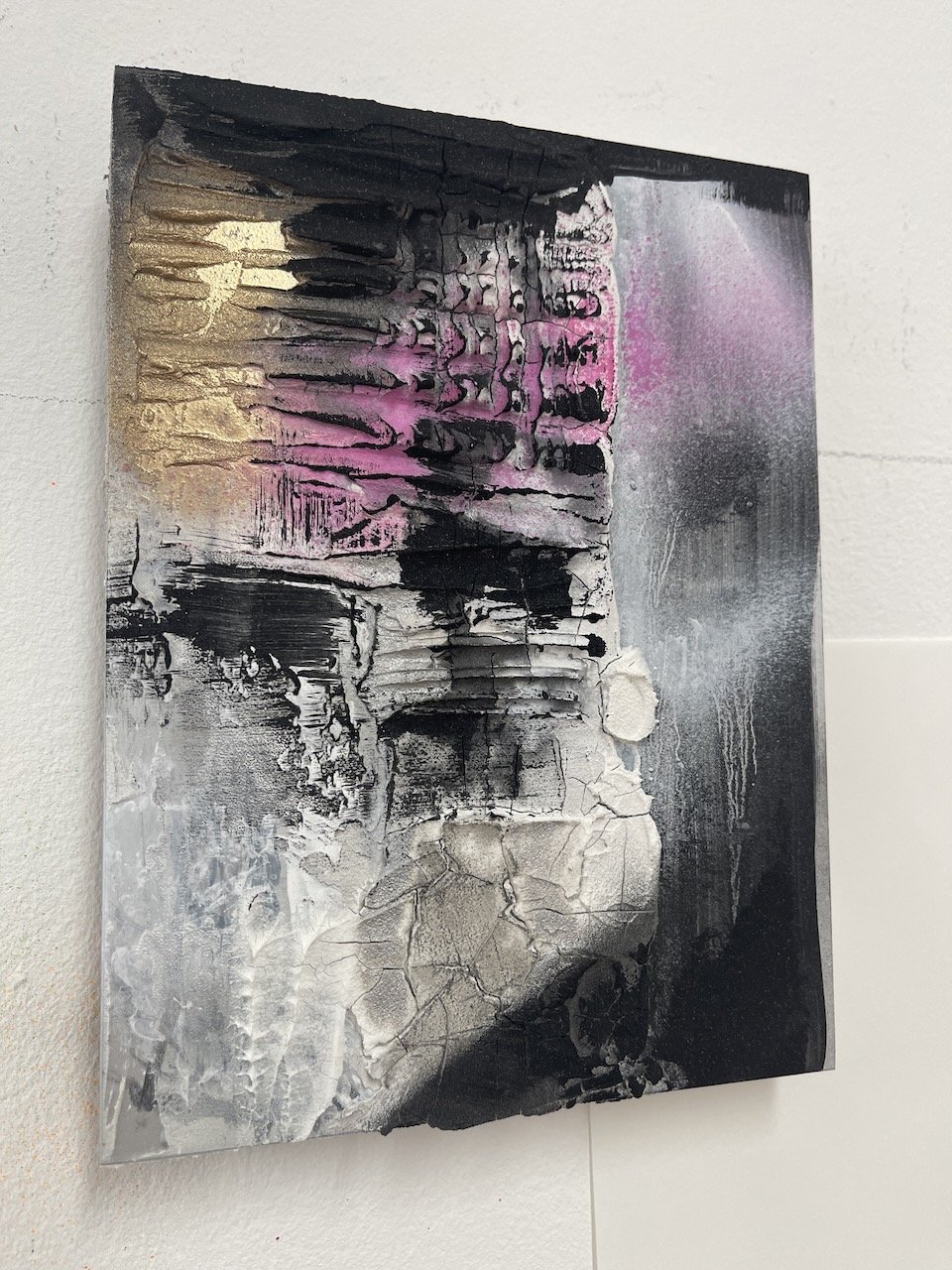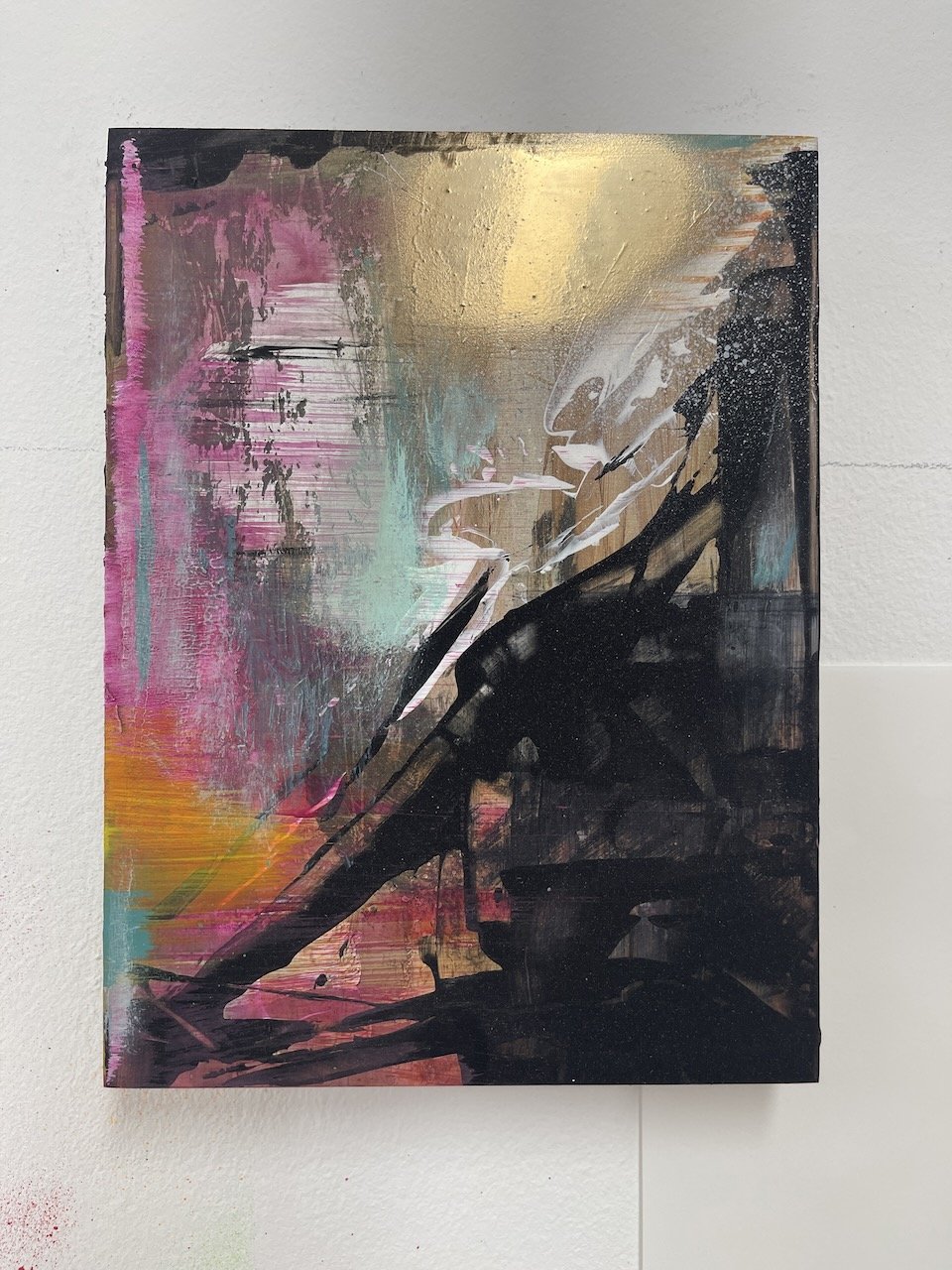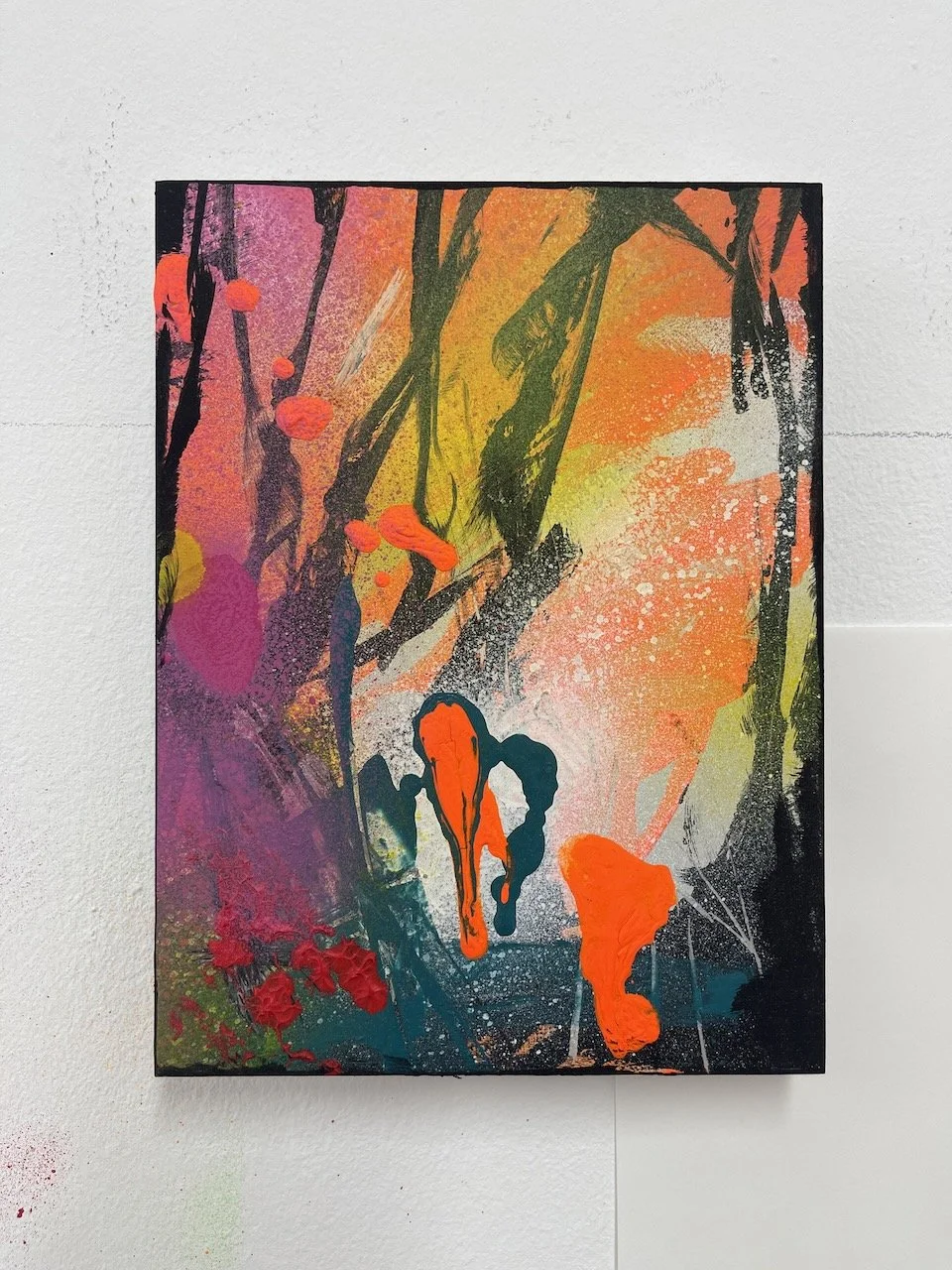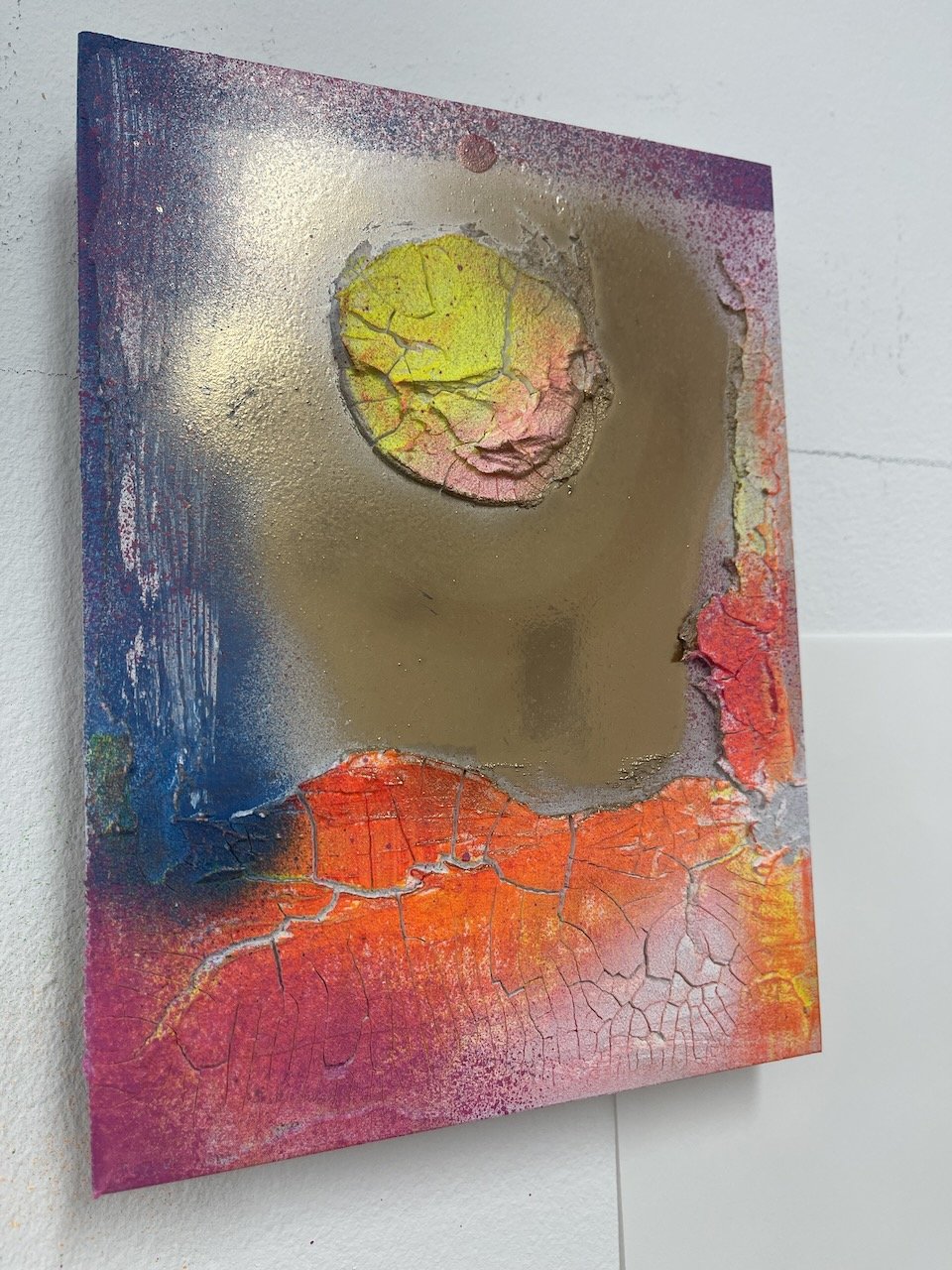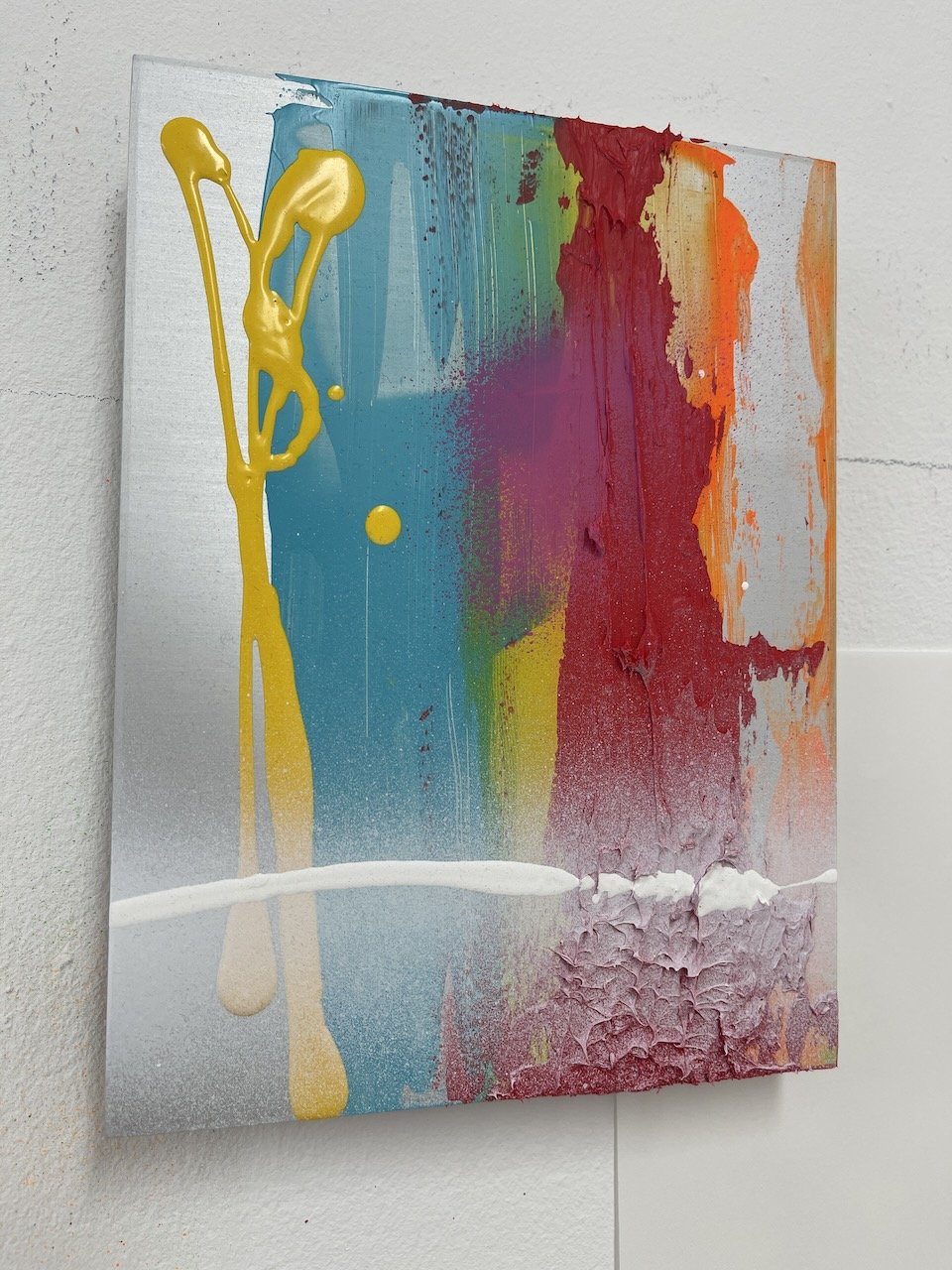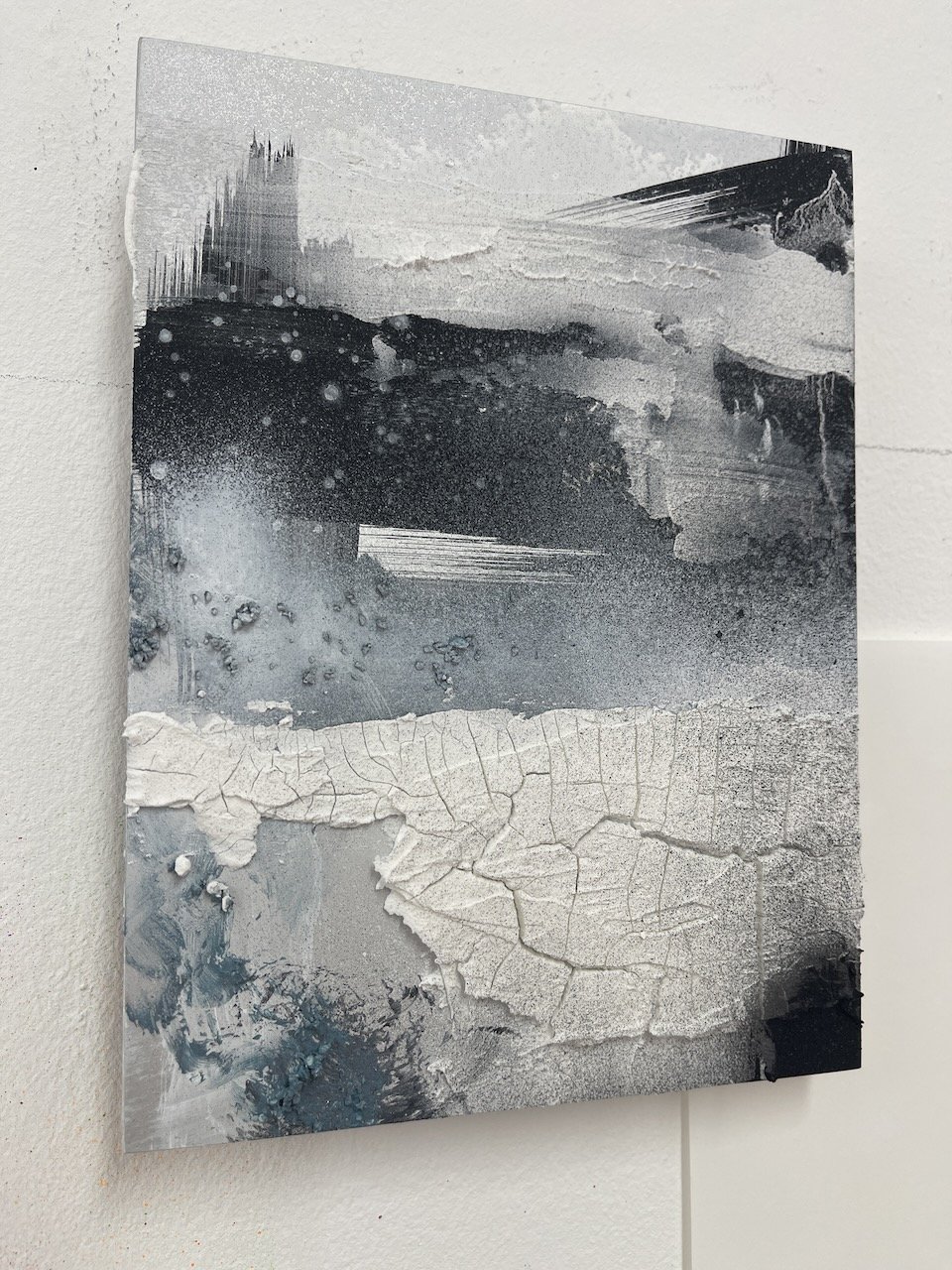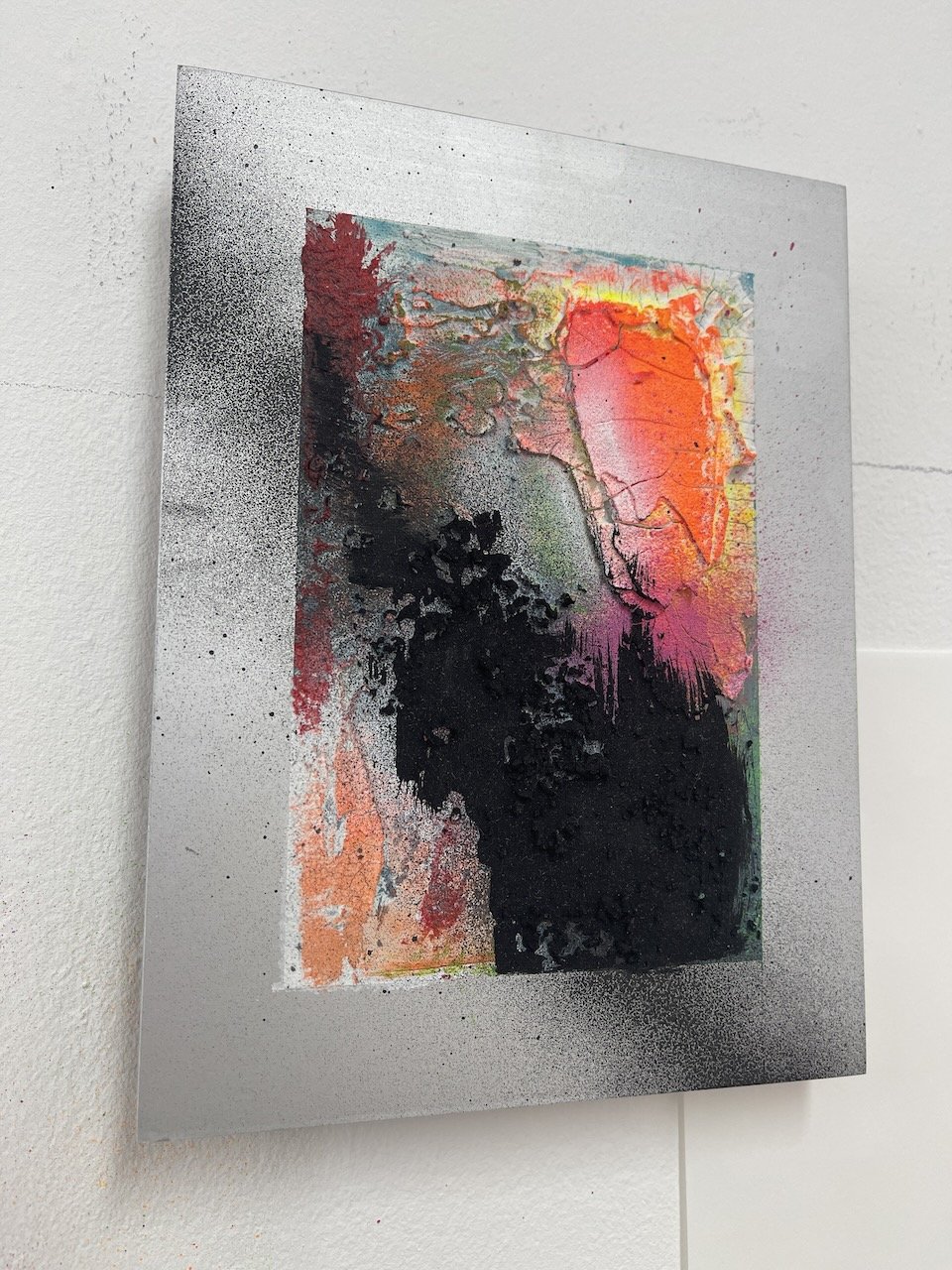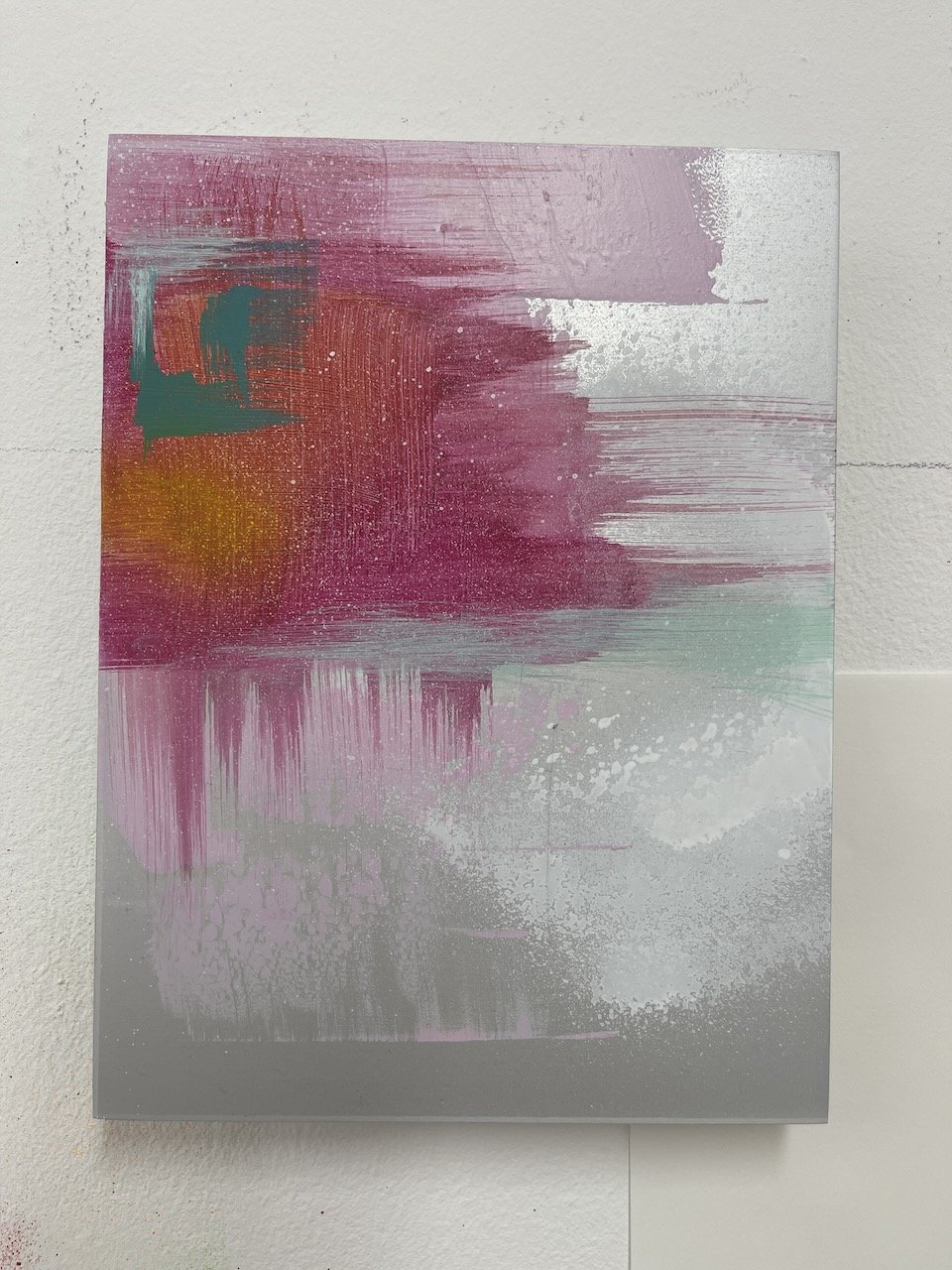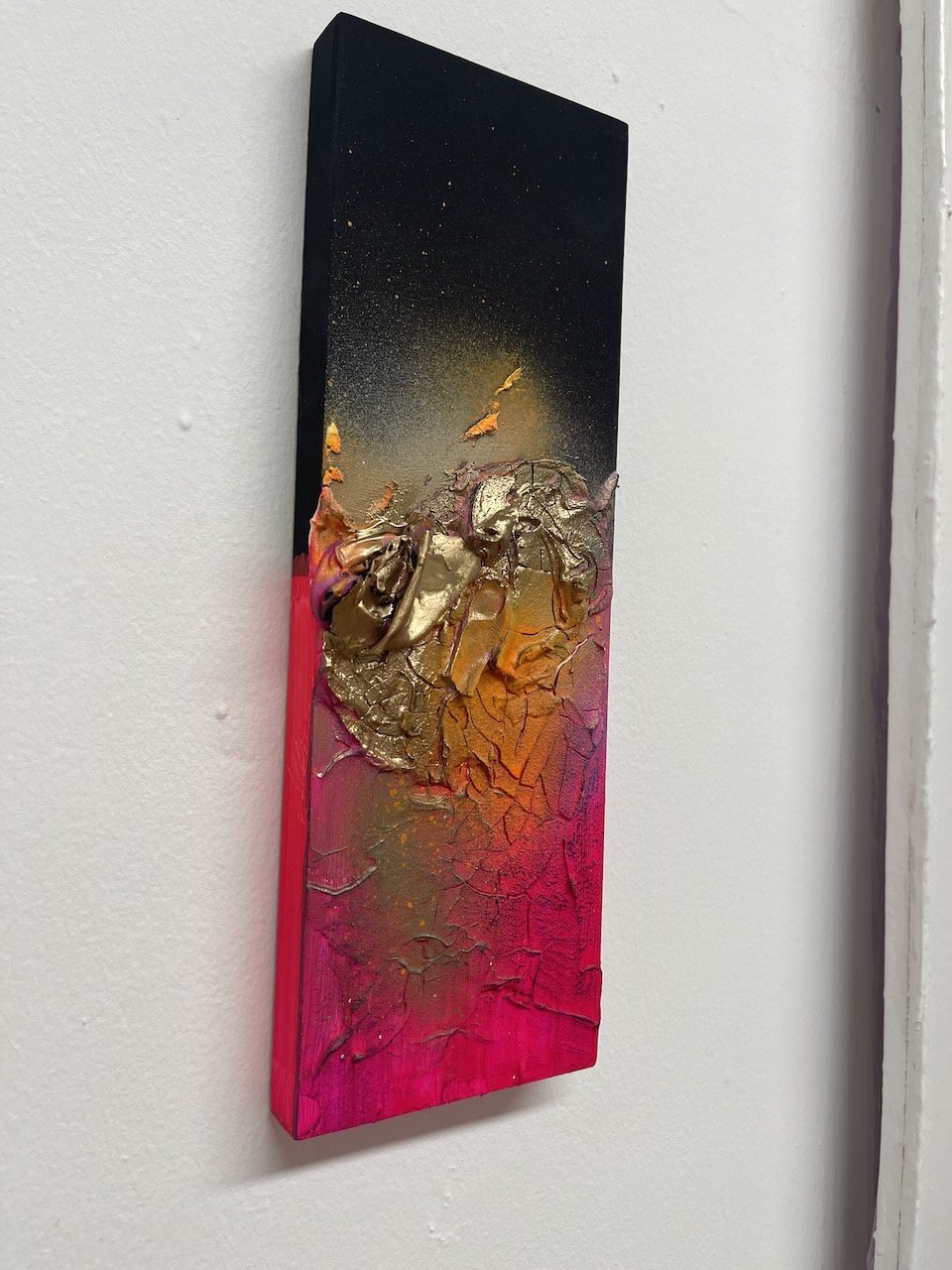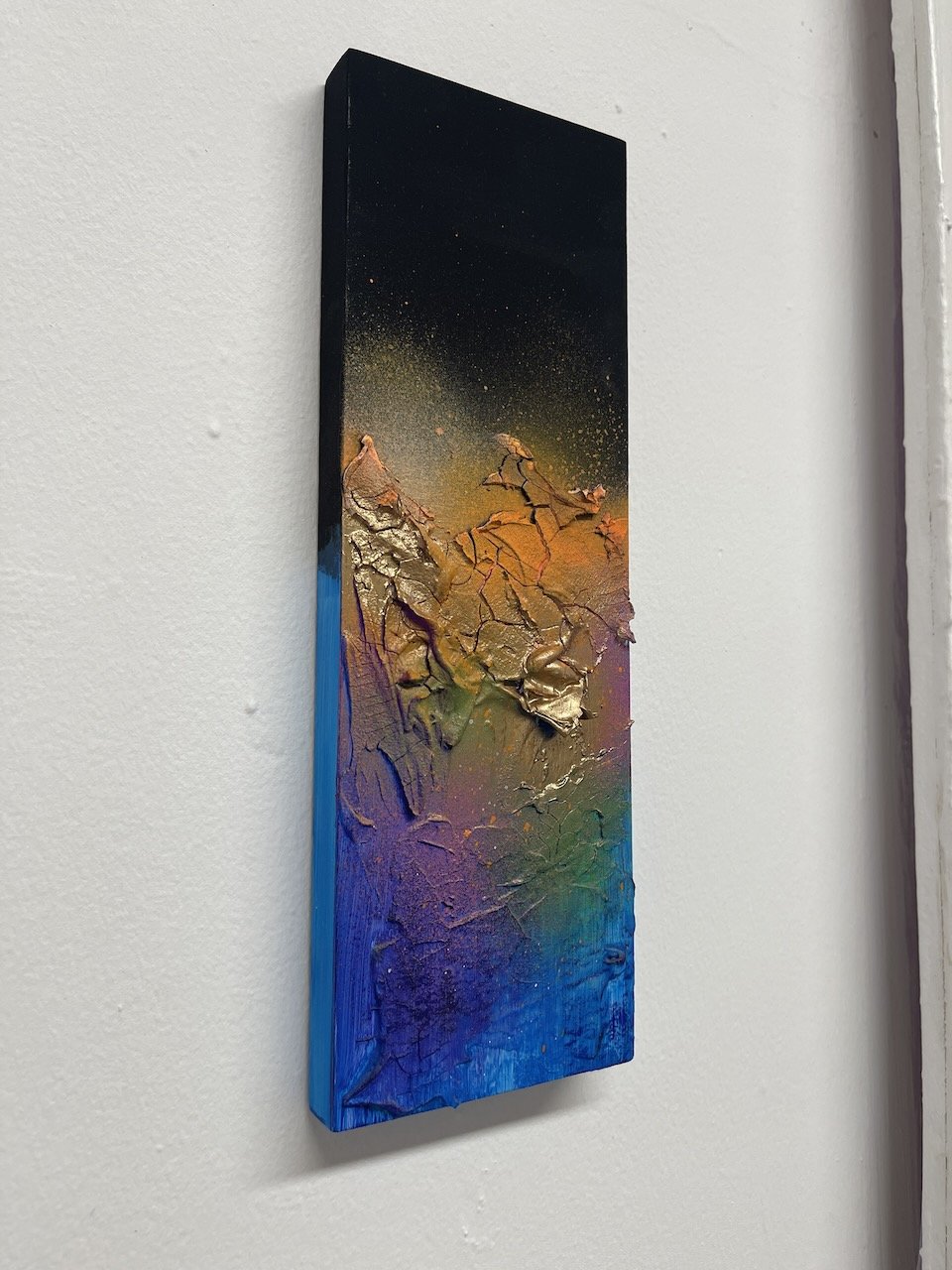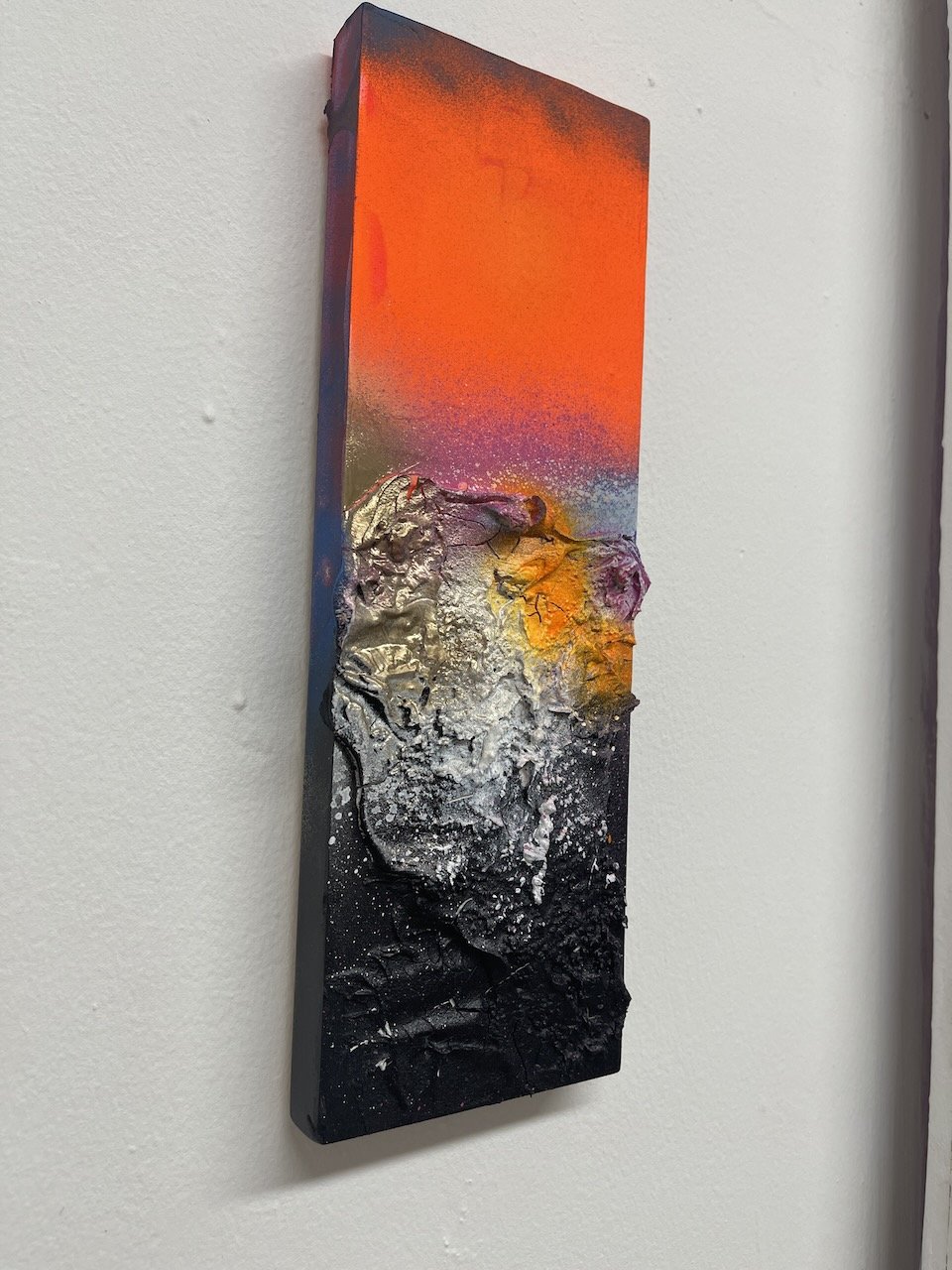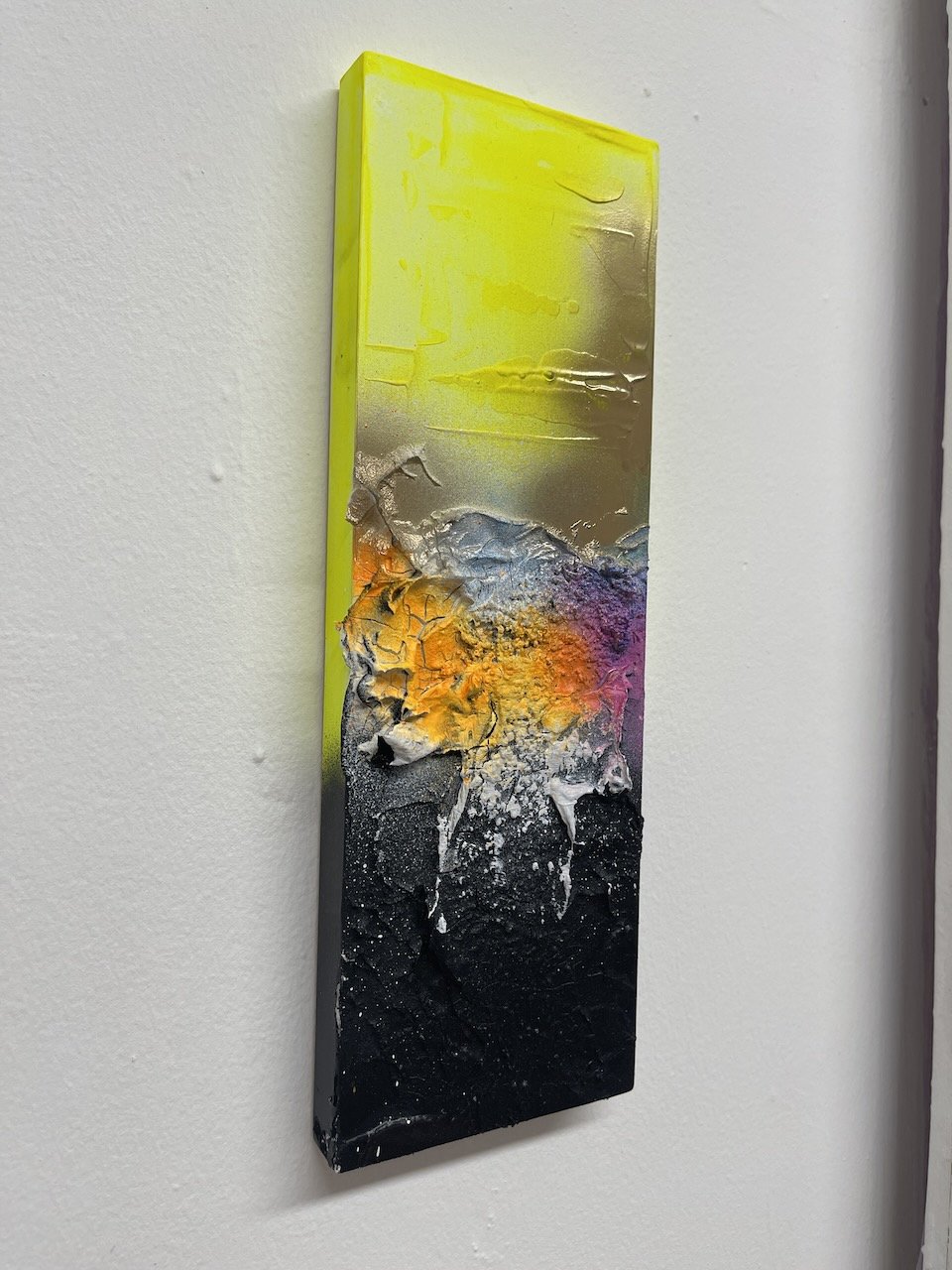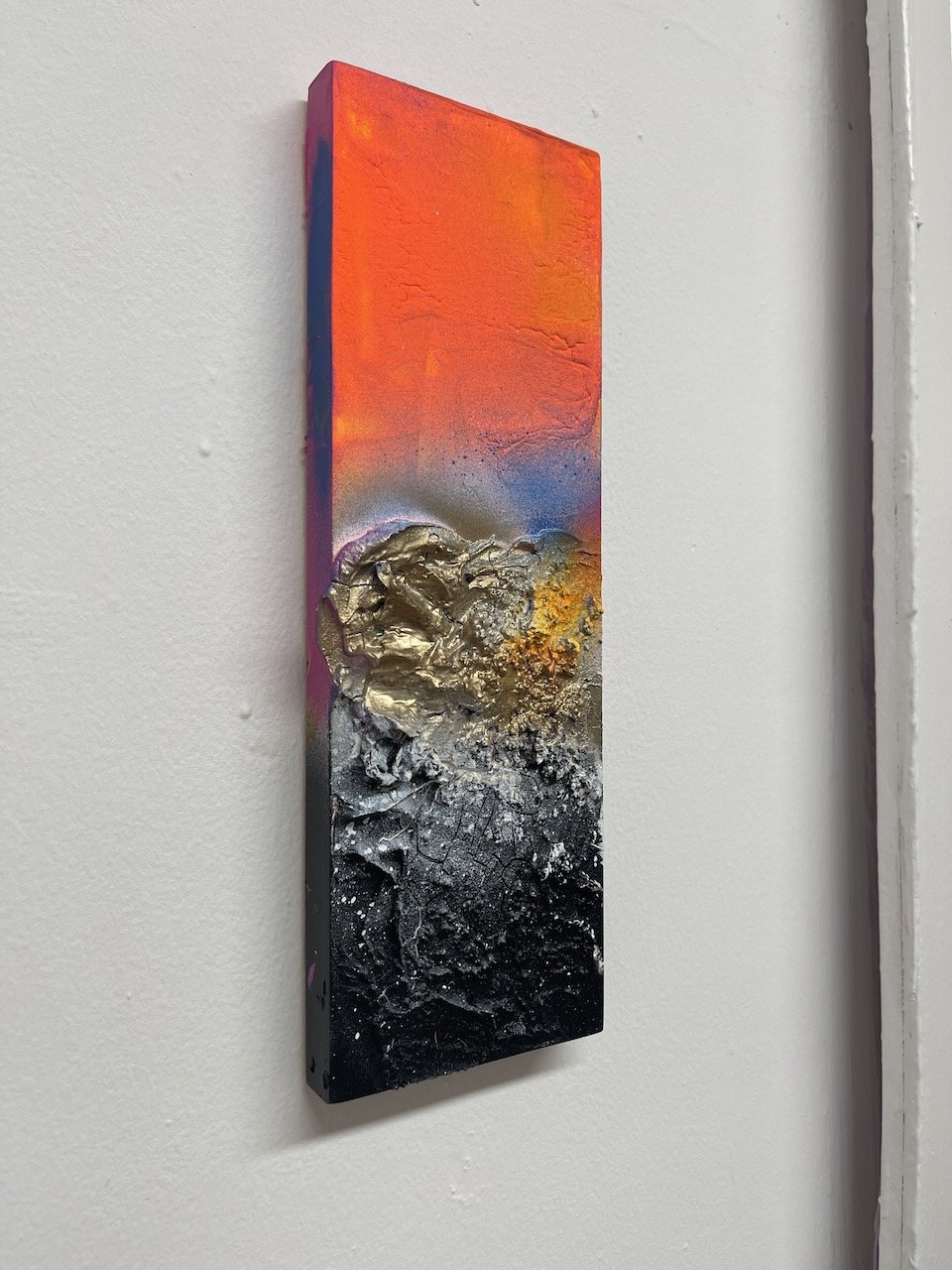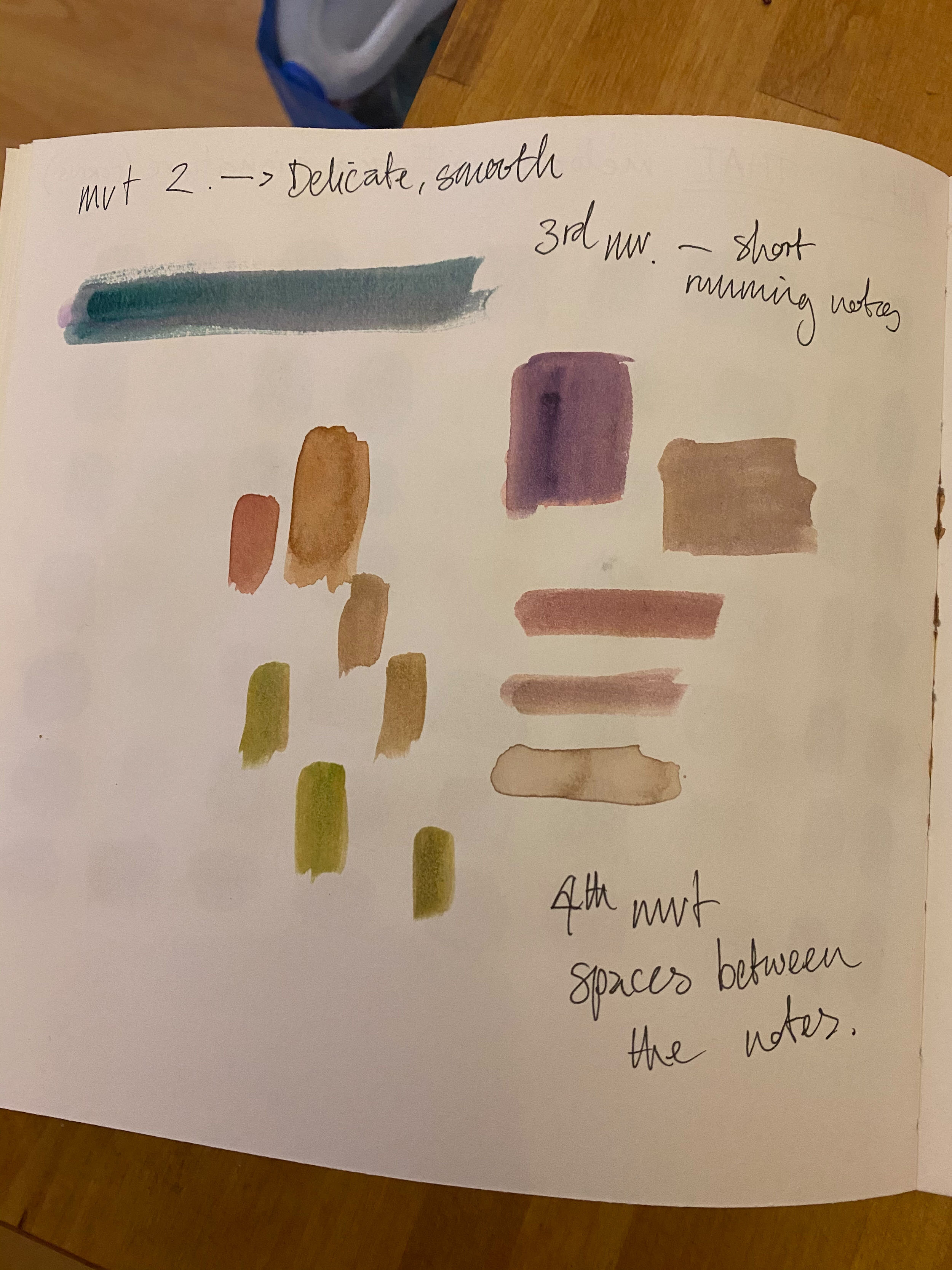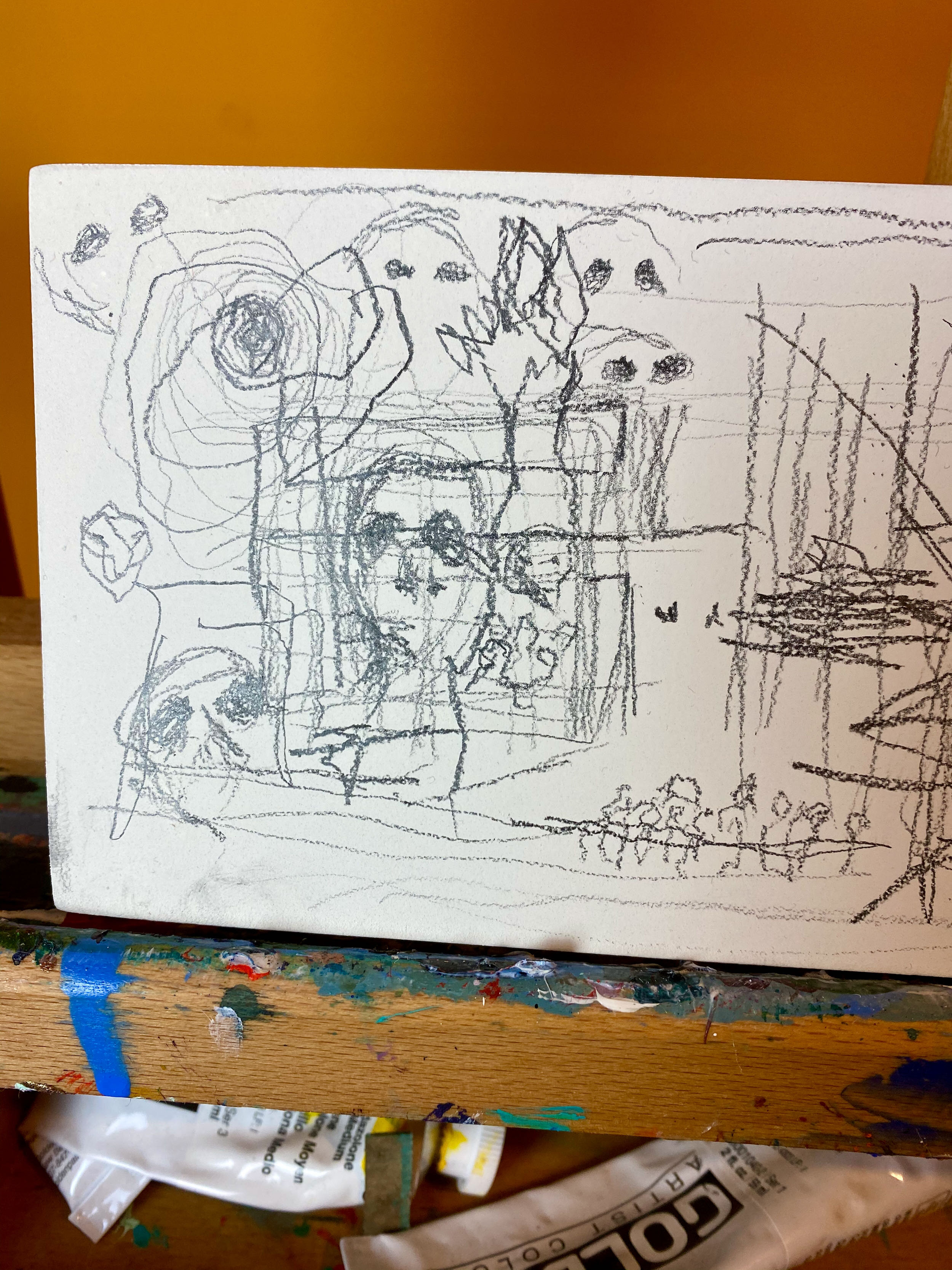The Origin of Colour
‘The Origin of Colour’ : Acrylic on Aluminium panels 50x120cm.
The Origin of Colour
I was so thrilled when the Scottish Chamber Orchestra had the idea to commission me to paint, Jay Capperauld’s new piece ‘The Origin of Colour’.
But let me go back to when I first heard ‘The Origin of Colour’. Jay came and visited me in my studio to see my work. We got on brilliantly and found out we both have synesthesia and lots to talk about on the subject of music and art. Jay then asked if I would like to hear a midi recording of his new piece. I leapt at the chance and the piece in turn leapt out at me.
From the first listen, even though it was a midi recording, colours were so evident to me throughout. Some pieces of music, for me, feel like they are literally ask to be painted. This was one of those. So I knew I wanted to paint it regardless of how that came about.
I was thrilled when the SCO agreed to commission the making of it. This meant I could get the materials I really wanted to use to capture what I was hearing/seeing.
When I heard the piece what immediately jumped out at me was Marvel Comics, Graphic Novels: modernity. This music is full of colour, excitement, wonder and power. It also has elements that reflect the immediacy of the comic genre. Comics have traits which are immediately recognisable and often that has led to the wrong assumption that the Art of comics must be somehow less worthy. Jay uses lots of syncopated rhythms and lots of threes against twos which have similar traits to movie themes, science fiction sound tracks but Jay - like the artists of Marvel comics - takes these traits and uses them in a sophisticated way. Your ear can never rest as this music moves with power and insistence, hurtling us towards the abrupt ending.
I think what Jay has done is genius. His piece is both familiar and new. This reflects the short story ‘The Origin of Colour’ by Calvino that Jay based his piece on. Calvino gives us a world devoid of colour which is imprisoned in a vagueness of greys or in Art terms, a world stuck in mid values. Then a meteor shoots across the sky bestowing colour to the world. But this colour whilst beautiful, is not peaceful. It is tumultuous colour, colour that hurts the eyes. The two main characters stumble from the grey into this new world of colour with one astonished by the new whilst the other is devoid of the ability to cope with the dramatic change.
I am surprised that no one has made Calvino’s stories - the collection is titled Cosmicomics! - into a graphic novel. Perhaps the writing has so much comic-type description already that it does not pose much of a challenge to be created into storyboard form.
I however am no comic-Artist and yet I felt all that drama of a comic, graphic novel, pop-Art. I wanted to reflect all of this in my work. So I ordered material that would reflect this - literally. I ordered five aluminium cradled panels 50x120cm to be made. These panels are similar in proportion to what is found in a graphic novel or comic strip and to finish off the resemblance I taped off an inch around each one to give them a border. The aluminium is modern, industrial and its reflective properties make these paintings live in a new way. When light changes so do the paintings, when you walk around the paintings they change. This man-made material makes these paintings live in a modern way.
Tidal, Undulating & Sinuous
My first challenge was the first colourless grey section. Jay uses ‘white noise’ to create this section. The Sibelius program that he used to create the midi recording does not do ‘white noise’. There was nothing for me to listen to.
What there was was my experience as a musician. I have done a lot of contemporary music over my playing career and done a fair share of ‘white noise’ playing. White Noise is the technique of making sound without pitch. For string instruments this generally means bowing on the bridge or other part of the instrument. For winds they are often asked to blow into their instruments without activating reeds, or buzzing into mouthpieces. For percussion there are infinite options as percussion is already divided into the two groups of ‘tuned’ percussion (marimba, vibraphone etc) instruments with pitch and non-tuned percussion.
Tidal: the first panel
a world without colour
So I looked at what Jay had written in the score and also read Calvino’s description and came up with the first panel. Here I used lots of acrylic mediums to create texture (one of the defining characteristics of white noise): crackle paste, modelling paste, heavy matt gel, and pumice stone paste. I also used acrylic spray paint.
I wanted to create a piece that gave the impression of being bumped around as Calvino describes his characters experience of this colourless world. I also wanted to show a journey through this landscape.
The only exception to this colourless place is the two lines, one gold and one copper. These are the two chords Jay put in this section to represent a flash of colour that happens in the female character’s eyes - a hint of the colour to come. The chords he constructed were clearly these metallic colours for me.
Driving, Volatile
Then colour is delivered to the world by a meteor and our ears are immediately thrust into an exciting pulsating world of orchestral colour.
Volatile: second panel
Colour arrives abruptly to the world
The colour that immediately sprung to mind was yellow, a corn yellow full of life and joy. Yet this colour is also pulsating and driving. I have a tool I use with acrylic which is a silicon wedge. I took this tool and attacked the surface with similar rhythmic stroke as if I was playing the notes. I wanted the texture to reflect the rhythm. You can see this in the bottom of the panel.
The explosive joy is that “splat” towards the top. For this I put the colours I was hearing on the aluminium surface and used a big stick to whack them to create that dramatic energy of flying paint. I also used florescent colours - particularly a very particular bright orange - but these don’t photograph well and so are best seen in the originals. I left some of the aluminium blank to reflect the old world underneath.
Lighter & Luminescent
The next section is full of washes of sound. Jay builds up chords that overlap and surge dynamically from soft to loud. Some are used with tremolo - a shaking of the bow on the string - or with the texture of col lego - tapping the string with the wood of the bow - whilst others are just pure sound with the bow.
Luminescent: third panel
colour washes over the world
Washes of sound, of course demanded washes of colour and Jay’s harmonies delivered those clearly to my synthetic mind. The textural delivery of some of the chords are reflected in the disintegration of the paint as it is pulled down the panel. At the bottom is the other significant part of this section where Jay has the strings in particular play descending glissandos (sliding down with the finger) as pizzicatos (plucking the strings). This brilliant effect sounds to me like fireworks whistling down through the night’s sky.
Lively, Primal and at times Agitated & Chaotic
The next section is primal, like Stravinsky’s Rite of Spring. It leaps out of the orchestra and dances. But that dance can be unpredictable and the ear is never allowed to settle for too long on one element. The reality of living with colour is a problematic one and in Calvino’s story this is especially true for the female character.
Primal: fourth panel
coming to terms with colour
This is the ‘funkiest’ of all the sections. It makes you want to move and dance. There are lots of explosions in it too - particularly using ‘Bartok Pizzicato’ where the string is pulled up and released down onto the fingerboard producing a very loud whack. I used a big stick to create this piece where I was both hitting the paint and pulling and pushing it. The bottom purple section is the part of this section which for me sounds like music from science fiction tv, otherworldly. I also applied the paint very thinly in part of this and left gaps to let the aluminium through to make the painting ‘live’ and also represent the pulling away of the two experiences of colour versus colourless.
Solitary; Calling out from an isolated place
The final section is where things really dissolve into two worlds.
Solitary: fifth panel
dissolution and end
Jay opens this section with a rhythmic pattern played on sandpaper blocks by the percussionist and above it the piccolo has a lamenting line. For me this piccolo line sounds other worldly in a science fiction way. I am still in that Marvel comic type world. The colour is there and the piccolo line is definitely pink, but it keeps getting interrupted by the colourless percussion.
I used tape to create gaps and disruptions in the surface. I also wanted to create a sense of the architecture coming apart. The result is an image that appears to swing out from itself and reminds me of an outer space existence.
Then it crashes into the vertical line. This textured line was one of those “problematic” moments in the studio. I had created bright colours and huge textures based on studies I had done on this crashing theme (see the end of this post for more info). But it just wasn’t working. So I did what all artists do (and composers too), I destroyed it and in that act of destruction it revealed itself. I added a wash of colour and the aluminium glowed back. It was what I was looking for.
The final end point is dark, and originally I had painted it black but black didn’t work. It was too cut off. The end of the story is the female character cut off from the world of colour by going into a colourless cave. But black didn’t work. I then realised when you have seen colour, you cannot un-see it. Just like how you get colour spots when you close your eyes, the abrupt sudden ending of this piece is not devoid of colour.
Studies & Investigation
These 6x4 inch aluminium pieces I used to experiment with the medium - find out how the paint would interact with the metal. They are available to buy for £50 each - email here.
These 12 by 4 inch boards I experimented with the notion of colour exploding into non-colour. They are also available to buy at £50 each - email here.
I am not inspired by Music
I
I paint music … I don’t paint “inspired” by music
When an artist paints a still life no one ever says that it is “inspired” by a still life; they say it is “of” a still life.
I paint music but my work is continually described by others as “inspired” by music. I do not see it this way. I am literally painting music as I “see” it.
Music for me is an entity in itself. It is an object that travels through time. Art is an object that is static in time. My job is translating the object of Music into the object of Art.
I am aware that this concept is strange to many people and may puzzle some. I do not paint Music as it travels through time note by note. My process is an editing of what I hear and then capturing the essence of the Music to show it in Art.
Still life is a good way for me to explain this: Cezanne’s still life paintings of apples are about so much more than simply trying to replicate the apples before him on the table. He uses the objects as vehicle to say something about how we look, how we see and capture form in paint. The apples become about the paint, the canvas, the brushstrokes.
Cezanne: Still Life with Quince, Apples and Pears (ca 1885-7)
I am using the object of Music as a vehicle to show in Art how our senses can intertwine; that Music has colour and form that we can see as well as hear.
Beethoven Symphony no.9 from 100 Days of Music as Art
My work is “of” Music but it is not Music itself just as Cezanne’s work is “of” apples but is not the apples themselves. You cannot taste the apples in Cezanne’s paintings. You cannot hear Beethoven’s 9th symphony when you look at my painting. You can see that Cezanne was representing apples in his paintings and you can see (hear), that I am representing Beethoven 9th symphony in my painting.
My art should remind you of the essence of the Music that I paint. Music is not my inspiration, it is the actual object of my work. In the hierarchy of subject of Music and object of painting, my subject dictates what happens in the painting. This is why my work changes depending on the Music I am painting: Stravinsky should not look like Bach; Messiaen should never look like Brahms.
If my work was “inspired” by Music then my art, my paintings would take precedence over the Music. Instead my Art is dictated to by the Music I am painting. If I think that a dab of pink would look good in the painting but the Music doesn’t have any pink in it then I cannot add pink. I am a musician even when I wield a paintbrush instead of my double bass bow.
4’33”
Silence.
The beginning and the end.
It is what music begins from and echoes into.
White is what painting begins from and so I return it to its origin.
But there is no such thing as silence as John Cage himself discovered when going into a special sound vacuum chamber. We cannot escape the sound of our breathing, our bodies, our heartbeat.
This painting of 4’33” shows that there is no silence. Underneath all the white is all the colour, all the paint, all the music that went into the 99 paintings that proceeded it.
It also symbolises, for me, what has happened to the music profession in the Covid Pandemic.
The forced silencing of concerts, of music, of performers playing with each other is there in every white brushstroke. It was a whiteout of silence. All that was left was white noise.
This painting represents that agonising silence at the end of all those recorded concerts where applause should have been. But again it wasn’t silent … all those people were listening and applauding in their own way behind the silence.
Silence has the echo of music. Silence is not silent. Music did not and will never, fall silent.
There is no such thing as silence in music … or absence in art.
Music and Art have prevailed and will continue to do so.
Number 3-5 of 100 days: Shostakovich, Beethoven & Mozart
Day 3: Shostakovich 10 movement 2. I love this piece and played it about a year ago with the RSNO - I miss playing it terribly! The second movement is like living on the edge - running very fast along a tightrope. It is exhilarating. I ended up hitting the paint on the canvas in time with the piece. I wanted a feeling too of Stalinist USSR about it - a nod to the aesthetic of USSR propaganda.
mark making with ink while listening
Mark making while listening
The response to this one was considerable and I had several offer to buy it. It was purchased by an orchestral musician who appreciates and adores this music - I couldn’t be more pleased!
Day 4: Beethoven Symphony 3, Eroica. Beethoven is the staple of all bass parts. It is in bass players DNA. I adore playing this symphony because the bass part really drives so much of it. I have always seen this piece as mostly green - lots of different shades of it. I don’t know why but I do. I don’t have synesthesia but I have some pieces of music that have definite colour associations for me.
Colour palette
I used watercolour and this time did all four movements in a quartet on one sheet. I’m not as satisfied with this one. It feels too timid for the epic symphony Beethoven wrote. I will revisit Beethoven during this project I am sure and hope to do him better justice.
Day 5: Mozart overture to The Marriage of Figaro. This overture is so cheeky, so fun, so mischievous. I feel you can hear Mozart laughing throughout. As all good overtures, this piece tells of the story to come in the opera - the cross dressing, the mischievous cunning plans, the love entanglements, the comedy. Yet in Yannick Nézet-Séguin’s hands with the Chamber Orchestra of Europe this overture is even brighter, even more exciting than older recordings - in short he makes it sound modern.
Detail
So inspired by that recording I decided to use watercolour on the very modern Yupo paper. I used the colours of carnival, of a masked ball to show all the capers and jokes Mozart intended.
Dido & Aeneas
The second painting I did was of the overture to Dido & Aeneas by Purcell. A needed contrast from Black Angels. This piece is all joy, colour, summer. I used watercolour and worked out my colour palette in my sketchbook beforehand. I was pleased with the end result.
However I was even more pleased, thrilled, when Sally, the wife of John Butt a professor of music at Glasgow University and music director of the Dunedin Consort, asked to buy it to give to her husband. John is conducting a performance of the opera at the Barbican this summer with the Dunedin Consort.
To have someone of this standing, who knows the music so well connect with my artwork is just a huge privilege! Hopefully the painting will be arriving at the home today.
Black Angels
Black Angels By
George Crumb
“Things were turned upside down. There were terrifying things in the air… they found their way into Black Angels.”
George Crumb 1990
So if you were hoping for a pleasant picture of a Debussy nocturne or a Mozart minuet, I am sorry that I have to disappoint. I have chosen ‘Black Angels’ by George Crumb for my first piece. It is an astounding piece and I urge you to listen to it.
Crumb wrote this piece for string quartet in 1971. It is subtitled “Thirteen Images from the Dark Land”. The players are expected to use lots of “extended” techniques where they play, hit, pluck, slide, scratch as well as sing, shout, speak text in different languages and also play some percussion instruments. The quartet instruments are instructed to be amplified and Crumb asks that the volume be turned up to the “threshold of pain”
This is a striking, emotional work that is both harrowing and beautiful. Crumb based it on the Vietnam war that was happening at the time and “electric insects” can be heard representing the US weapon of choice - the helicopter. He also commented that this piece portrays a voyage of the soul from departure and fall from grace to absence where the soul is annihilated to finally return and redemption.
Black Angels are of course fallen angels and nightmarish in their story and in this music they haunt and disturb in equal measure. This piece always moves me to tears. It is painful, harrowing and yet also beautiful: how we can see beauty in pain.
So I chose a particularly challenging first piece to do. I listened to it and wrote lots of word associations of what it felt to me. The words pain, cry, trapped, lost, alone, children, threads and fragility were particularly strong.
I then did some research on the piece itself and listen to three different recordings (I’ve spent a lot of time on this today). Then I got out a long thin prepared board to do the work on.
I began by doing a pencil drawing that I thought would be the basis for it. I did this while listening of course. There are faces, figures, cages, death and the maiden and the iconic image of the little girl running from a napalm attack.
Then I was thinking if I should focus on one small section, do I do a figure, do I make it specific, a narrative? Then I thought should I do many paintings of this. I could do a whole series of paintings on this music.
And I could - and may at some point! But I reigned myself back to my purpose and got another board and painted an emotional response to what I was hearing.
I see these black, red, white and golds in the music. I also needed to scratch and have a rhythmic mark making - as a string player myself my right hand with a palette knife is so similar to holding a bow where all the rhythm resides. I have always ‘seen’ those colours listening to this (I have been listening to this piece since my late teens).
I did also practice my double bass today and I was happy to discover that I feel like I was more engaged with the artistry of making notes sing rather than berating myself for the failings in my technique which I always vow to be working on. I hope that the interplay between my art and music will prove to benefit both.
100 days of Music as Art
I didn’t think this would be easy. I was, am, daunted by this challenge: create a piece of artwork reflecting a piece of music each day for one hundred days.
How do I do justice to the medium of sound that I love so much, that connects so directly with my emotions. This is a tall order.
So why on earth do it? This is after all a self inflicted challenge. No one is holding me to this except myself.
I think I am enticed by this challenge is a desire to connect to music again. This pandemic has silenced the concert halls and I have not played in an orchestra for ten months. For a musician this hurts - physically hurts in our being. Like we have lost a part of ourselves.
Listening to music has been painful, it is getting easier. I want to listen to music for the purpose of creating art because I think it will inform my listening, my appreciation of music as much as it will affect my art work.
I am very aware of Kandinsky and how he used music to inspire his own art and further it towards abstraction. I intend to do research into Kandinsky and his approach, however I have to confess to not liking his work very much. I could change my opinion as I explore it further but it doesn’t have an emotional connection for me which I feel essential to any discussion or appreciation of music.
I am unsure how I will pick which pieces to create from. Do I focus on different composers which sound different to each other - have their own sound colour palettes or specific, favourite pieces? Do I stay with music I know or explore into realms I’ve never been? There are many possibilities. We will see where the journey takes me.
To follow along please go to Instagram and follow my account @kirsty_matheson_art (you can also click on the camera icon in the top right hand corner of this webpage) and also my hashtag for the project #100daysofmusicasart
I welcome any feedback so if you feel like it, do get in touch.








